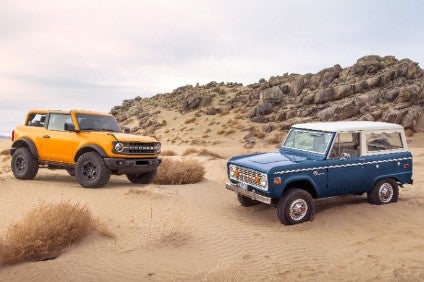Renault caused a stir last week by announcing its bold new business strategy aimed at reducing costs and increasing profitability as it transitions to electrified vehicles and new mobility. Among a brace of new strategy directions were a number of new model announcements including a three-vehicle line-up for performance brand Alpine and the C-segment Dacia Bigster SUV concept.
However, the model that immediately started making headlines was the new Renault 5 EV concept. This compact supermini features a modern battery-electric powertrain but exterior styling that’s strongly reminiscent of its namesake predecessor launched in 1972. From the trapezoid headlights, to the simple, timeless bodyshape, to the blistered wheelarches and contrast roof details that recall the Renault 5 Turbo rally legend, it’s unmistakably retro in flavour.
Judging by the immediate positive reaction to the concept 5’s looks, Renault might be on to a winner when it launches sometime before 2025. In that time, a number of different retro-inspired new models from other brands will launch, many of which grabbed similarly excitable headlines when they were revealed. It begs the question – why is the automotive conversation becoming so dominated by these retro-inspired vehicles?
The most successful models to resuscitate older nameplates blend the best features of their forebears with modern technology. This can be seen in the near unanimous acclaim received by the 2020 Ford Bronco concept. It captures the squared, bluff looks of the 1966 original but uses modern running gear and engines borrowed from the Ford Ranger pickup. Inside, a rugged cabin strikes a balance between utilitarian design with large, chunky controls and hose-down footwells, and the modern technology buyers expect such as an infotainment system and ADAS features.
The launch of retro models is a chance to reset brand image and provide the market with a reminder of why a brand was successful in the first place.
Those with slightly longer memories might recall the auto industry has already seen a retro design trend emerge in the early 2000s. Following the curvy designs of the 1990s, manufacturers were looking to distinguish their line-ups. This led to models such as the 1997 VW Beetle, the 2000 MINI Hatch, the 2007 Fiat 500, the 2005 Ford Mustang, or the 2000 Chrysler PT Cruiser – all of which had distinctly retro-inspired styling, marking them out from other contemporary models. As the years rolled on, some remained in production with their looks updated over time, while others went out of production as trends evolved.
Almost all of these retro-inspired examples from today and the early 2000s traded on nostalgic nameplates – familiar model lines that had existed for decades and built up positive sentiment over time. This process can be exploited even for vehicles that don’t have conspicuously retro styling – a recent example would be the Ford Mustang Mach-E. While the Mach-E doesn’t look like either modern or classic Mustangs, it still uses the nameplate to tie it to the romanticised image conjured up. This is a high-risk strategy – if it pays off, it could help the new model capture more buyers based on its image but, if it fails, it could do lasting damage to the Mustang lineage and potentially affect sales of other Mustang-branded vehicles. Rumours have suggested that Chevrolet could be considering a similar strategy by expanding the Corvette brand to include more models than just the legendary sports car, trading on the kudos the Corvette name would bring.

US Tariffs are shifting - will you react or anticipate?
Don’t let policy changes catch you off guard. Stay proactive with real-time data and expert analysis.
By GlobalDataSo, why do so many manufacturers chase retro design? One reason is simply to differentiate their new models, especially in a market where many vehicles have started to look quite similar as a result of conservative styling and the impact of safety and efficiency regulations. Another is to capture the positive nostalgic sentiment these older cars generate – especially at a time when many are facing an especially challenging period due to the ongoing COVID-19 outbreak, a little slice of the ‘good old days’ is seen as a welcome relief to many potential buyers.
Additionally, the desire for retro could stem from OEMs being stuck in something of a rut. They might have lost their mojo with new models failing to resonate with buyers. The launch of retro models is a chance to reset brand image and provide the market with a reminder of why a brand was successful in the first place.
There are parallels with the music industry, where tricks such as a greatest hits compilation, a live recording or a collaboration with a more current artist can regenerate interest in the fading act. Renault, which, in the 1990s and 2000s, enjoyed market success due to its reputation as an innovator, has been in something of a slump since. Its West European market share has dwindled from 10.5% in 2000 to 7% in 2020, with its recent products failing to bring the market success of innovations such as the Espace and Scenic in the 1990s. The Renault 5 EV looks sure to bring success, but sustaining that success will be key. All too often, retro products bring a short-lived boost to a brand in the market. Renault will be hoping that following up initial success will not end up like so many recording artists’ difficult second album.
This article first appeared on GlobalData’s research platform, the Automotive Intelligence Center
See also: Renaulution – the future models changes




